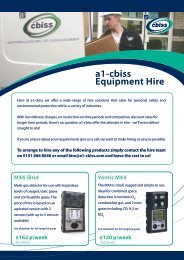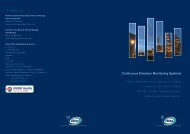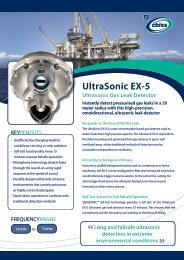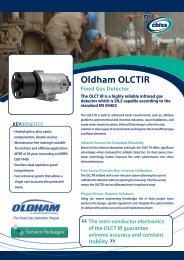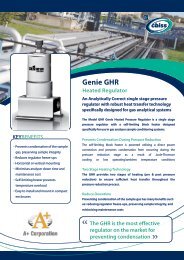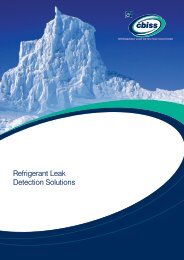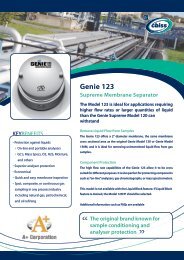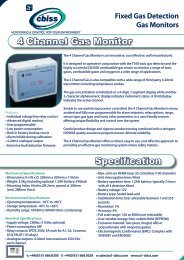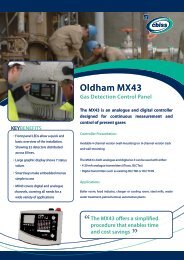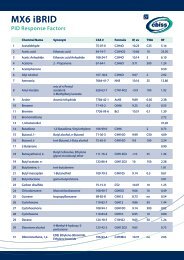VOC 72M Volatile Organic Compounds Analyser Datasheet - A1 Cbiss
VOC 72M Volatile Organic Compounds Analyser Datasheet - A1 Cbiss
VOC 72M Volatile Organic Compounds Analyser Datasheet - A1 Cbiss
- No tags were found...
You also want an ePaper? Increase the reach of your titles
YUMPU automatically turns print PDFs into web optimized ePapers that Google loves.
<strong>VOC</strong><strong>72M</strong>Gas Chromatography <strong>Volatile</strong> <strong>Organic</strong><strong>Compounds</strong> (BTEX) <strong>Analyser</strong>The <strong>VOC</strong><strong>72M</strong> provides equal performanceto the laboratory chromatographs and isparticularly well-suited for fixed or mobileambient air quality monitoring stations.KEYBENEFITS• Remote diagnosis, made possiblewithout opening the hood• Robust and low maintenanceinstrument, (no PID lamp cleaning)• High sensitivity, stable and linearresponse PID detector• 3 levels of built-in security• On board web serverCOMPOUNDSMEASUREDBenzeneEthylbenzenem+p-XyleneTolueneo-XylenePortable and Fixed Ambient Air Quality MonitoringThe <strong>VOC</strong><strong>72M</strong>’s metrology, in accordance with EN 14662-3 standard forbenzene measurement, is based on gas chromatography (GC)for the separation of the measured compounds coupled with aphoto-ionization detector (PID).Compact & Fully AutomatedReady to use in less than 30 minutes, the <strong>VOC</strong><strong>72M</strong> performssampling, analysis and data management, in a simple and completelyautonomous mod.View Diagnostics & Peaks Without a PCThe <strong>VOC</strong><strong>72M</strong> utilises the use of a memory effect (up to 10 times lowerthan required by the standard EN14662-3) allowing the automaticcalibration of the analyser on a single cycle without an external PC. Aquick check of the screen indicates the chromatogram peaks.“Portable & fixed measurementof ambient air in accordancewith EN 14662-3“
TECHNICALSPECIFICATIONPERFORMANCE• Measured compounds: Benzene, Toluene, Ethylbenzene,m+p-Xylene, o-Xylene (other compounds on request)• Cycle duration: 10, 12, 15, 20, 30 minutes• Gas supply: Nitrogen 6.0 (99.9999%)MEASUREMENT RANGES• Measuring ranges: maximum 1000μg/m3(programmable)• Units: ppb or μg/m3 (programmable)• Measuring noise (s): ≤0.025μg/m3 at 0.5μg/m3 benzene• Lower detectable limit (2s): ≤0.05μg/m3 benzeneCAPABILITIES• Carry-over (memory effect): ≤0.5% on the first zero• Long-term span drift: ≤4% on 15 days• Repeatability standard deviation: ≤0.05μg/m3 at 5μg/m3benzene• Sample flow: 50ml/minute• Sampling temperature: 35°C• Desorption temperature / heating rate: 380°C(programmable) / > 160°C/secondPOWER• Serial link: RS232 or RS422• Ethernet port: RJ45 socket, UDP protocol• USB: port USB socket format 1.0• Power supply: 100–240V + ground ; 50–60HzOPTIONAL• ESTEL electronic board with: 4 independent analog inputs(0-2.5 V) / outputs (0-1 V, 0-10 V, 0-20 mA, 4-20 mA), 4remote control inputs, 6 dry contactsPHYSICAL• Dimensions: 601 mm x 483 mm x 133 mm (LxWxH)• Weight: 12.5 kgOPERATINGPRINCIPLEThe <strong>VOC</strong><strong>72M</strong> performs three main functions: the sampling,the GC analysis and the data processingSAMPLINGThe sampling is achieved with a single trap filled with a specificsorbent. Its flow through the trap is about 12 ml/min which givesa sampled volume of 165 ml with the standard 15 minute cycle(sampling time >90% of cycle time). Other cycle durations arepossible from 10 to 30 minutes. A bypass flow of 35 ml/min is addedin order to maintain a sample input flow when the trap is notsampling.GC ANALYSISAt the end of the sampling cycle, the trap is connected to the GCcolumn and quickly heated (35 to 380°C within 2 seconds). Thecompounds are thermally desorbed and flushed with nitrogen intothe GC column. Then the trap is quickly cooled with a fan for a newsampling cycle. Inside the GC column, the compounds are movedforward by the nitrogen flow (the mobile phase) and retainedby the internal coating (the stationary phase) causing a selectiveretardation of the compounds. In order to achieve an optimalseparation within a minimal time, the GC column follows a multiramp thermal cycle from a cold step (25°C) for the injectionto a hot step (160°C) for flushing all the heavy compounds (i.e.compounds with a high boiling point). At the end of the hot step,the GC column is cooled to the cold step for the nextinjection. The GC column output is connected to a photo ionizationdetector where the compound concentration is converted into asmall electric signal. This signal is amplified and digitized in theelectrometer board. The time recording of this signal gives thechromatogram which exhibits a peak for each detected compound.DATA PROCESSINGThe ARM7 board processes the chromatogram. When a peakretention time falls into a compound retention time window(typically ± 2 seconds), this peak is identified as the compound. Thepeak area is corrected with a volume calculation (based on the trappressure during the sampling) and the atmosphericpressure compensation for the detector response. The correctedarea, multiplied by the compound response factor, gives thecompound’s concentration.11 Ark Royal Way, Lairdside Technology Park, Tranmere, Wirral, CH41 9HTT: +44(0)151 666 8300 F: +44(0)151 666 8329 E: sales@a1-cbiss.comW: www.a1-cbiss.com Buy Online: shop.a1-cbiss.comCert No. 996ISO 9001



